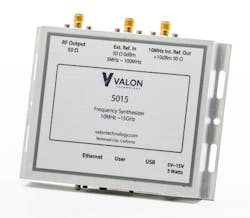Miniaturization has become an increasingly important requirement in many high-frequency systems, even though the complexity of some components, such as frequency synthesizers, can be challenging to fit into a compact housing. Meeting that challenge for small synthesizers in a big way, the 5015 frequency-synthesizer module from Valon Technology tunes from 10 MHz to 15 GHz with low phase noise and spurious products. It also offers fast tuning speed in a compact housing measuring just 3.2 × 4.3 × 0.485 in.
Typical phase noise for the module is −114 dBc/Hz offset 1 kHz from a 1-GHz carrier and −138 dBc/Hz offset 1 MHz from the same carrier. The phase noise, as expected, is somewhat higher at higher frequencies, but still impressive, with −94 dBc/Hz offset 1 kHz from 10-GHz carrier and −120 dBc/Hz offset 1 MHz from the 10-GHz carrier. Spurious products are −60 dBc or less. Harmonics are typically −12 dBc.
The model 5015 frequency synthesizer module (Fig. 1) operates on a wide input voltage range of about 5 to 15 V dc, with about 6 W power consumption, thanks to an efficient, low-noise switching preregulator. The synthesizer is designed with multiple phase-locked loops (PLLs) for low phase noise. It tunes in frequency increments of 1 Hz to 4 GHz and in increments of 10 Hz at frequencies higher than 4 GHz. It locks to a new frequency in less than 100 μs.
1. This compact, lightweight frequency-synthesizer module tunes from 10 MHz to 15 GHz and measures only 3.2 × 4.3 × 0.485 in.
The 5015 offers a calibrated output power range of −20 to +13 dBm, which can be set in 0.1-dB steps, with output-power accuracy of ±0.9 dB or better. It has an output-power range of −30 dBm to better than +10 dBm from 10 to 100 MHz, better than +15 dBm from 1 to 6 GHz, and better than +13 dBm from 6 to 15 GHz.
An internal temperature-compensated crystal oscillator (TCXO) provides ±2-ppm stability over a temperature range of −20 to +70ºC. In addition, an SMA input connector will accept reference signals from any external clock from 5 to 100 MHz in 0.2-MHz increments. The 5015 can be operated with an external reference source that supplies at least −10 dBm power.
The synthesizer module can be controlled by means of Ethernet (Fig. 2), transistor-to-transistor-logic (TTL) serial, and Universal Serial Bus (USB) interfaces, with the firm offering a graphical user interface (GUI) for use with the USB connection. The device does not draw power from the USB interface, but can be powered by any 5- to 15-V dc source or an optional PS6V-1 power-supply kit, available from Valon. In addition, the Eth-01 Ethernet Adapter is also available as an accessory. It allows the frequency synthesizer to be remotely mounted as far as 8 in. from the location of the Ethernet connector, for use in bulkhead panel-mount applications.
2. The 5015 frequency-synthesizer module can be operated via a number of different interfaces, including Ethernet and USB.
The 5015 exhibits output return loss of better than 6 dB from 10 to 100 MHz, 10 dB from 50 MHz to 10 GHz, and 6 dB from 10 to 15 GHz. It weighs just 0.37 lbs, (165 g) with SMA female output connectors, and can be operated at a case temperature of 0 to +60ºC.
Valon Technology LLC, 750 Hillcrest Dr., Redwood City, CA 94062; (650) 367-1059, E-mail: [email protected].



